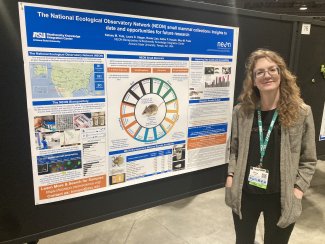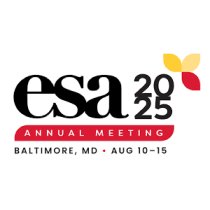NEON at ESA 2024: Forecasting, Partnerships, Samples, and More
August 16, 2024
Ecology is everywhere, from the mountains to the marshes to the beach. More than 3000 ecologists from around the world flocked to Long Beach, California this August for the 2024 Annual Meeting of the Ecological Society of America (ESA). We were excited to participate and have the opportunity to meet existing and prospective data users, explore partnerships, and learn how the community is using NEON resources.
As a program fully funded by the U.S. National Science Foundation – and managed by Battelle – the data and resources of NEON are freely available and open to all. From scientists to educators to private industry and more, NEON users can overcome barriers to doing ecological research such as difficulty getting into the field or needing knowledge of how to work with large data sets. Through the NEON Data Portal and the Learning Hub on neonscience.org, curious minds can access tools to answer complex environmental questions, investigate specific ecosystem drivers, or learn the skills to work with Big Data.
At ESA, the NEON booth had lots of traffic, and many people were interested in learning about NEON data. NEON staff and leadership members also participated in several contributed talks, short courses, and workshops. Here are a few highlights.
Partnering for the Future of Ecology
Science is not done in a vacuum. Relationships, connections, and engagements all serve to drive research and discovery. As the use of NEON products and services has grown, so has the breadth and depth of NEON’s partnerships and the scope of its impact beyond ecosystem sciences. At ESA, Chris McKay, Operations Manager at NEON, discussed this topic and what is being done at NEON to forge new connections in the science community. A focus of McKay's presentation, co-authored by Dr. Paula Mabee and Dr. Kate Thibault, was the key partnerships NEON has with several Department of Energy (DOE) facilities, including the Joint Genome Institute, the National Microbiome Data Collaborative, and the Environmental Molecular Sciences Laboratory. These collaborations are enhancing the accessibility of NEON data and the use of NEON samples, generating new data products that serve new biological research communities. NEON infrastructure and staff are also playing a crucial role through NEON Research Support Services (NRSS), with projects including soil sample collection from NEON sites for the DOE’s Molecular Observation Network, which will shed light on molecular and microscale soil processes. McKay also highlighted other areas of collaboration, including the recent transition to using the Google Cloud Platform, where NEON data are positioned to support the development of AI methods to expand many areas of science.
Training Models to Predict Rain Throughfall
How much rain actually reaches the ground if it has to fall through vegetation like trees and bushes? Dr. Ed Ayres, an Environmental Scientist with NEON, displayed a poster at ESA showing how researchers can make predictions for this question. Throughfall (the amount of water that reaches the ground after passing through or dripping off the plant canopy) is a critical input of water into ecosystems, and it can be intercepted by the plant canopy and evaporated. Currently, researchers lack an understanding of the most important factors needed to predict throughfall amounts across a wide range of sites, which is important for this flux across large spatial scales.
Ayres used five years of NEON data across the U.S. to train and evaluate models of varying complexity and with differing precipitation amounts. Across all sites, throughfall accounted for roughly 71 - 86% of precipitation, with a greater percentage of water reaching the ground in events with higher total precipitation. This indicates that with more rain, plant canopies are being saturated and allowing a greater percent of that total to reach the ground, although factors that influence evaporation rates (e.g., temperature and relative humidity) and forest structure (e.g., canopy height and tree cover) modify this amount. Predictions from the simplest model were typically within 28% of the actual observed throughfall, with greater accuracy from the moderately complex and most complex models. Based on these findings, these models should be able to predict throughfall with some confidence in U.S. ecosystems when the appropriate and needed data are available.

Ed Ayres discussed his work on testing the accuracy of precipitation throughfall across large spatial scales, using NEON data.
Investigating Accuracy of Beetle Forecasting
Can we predict how many beetles will be in an ecosystem at some point in the future? NEON Ecologist Dr. Eric Sokol presented a talk regarding the forecasting of beetle abundances at NEON sites through the NEON Ecological Forecasting Challenge. The data used contain taxonomically-identified ground beetles (Carabids) from pitfall traps and the plots and times from which they were collected. The goal was to use climate model outputs as drivers of the forecasting, evaluating simple forecasts using the latest complete year of NEON data.
Sokol and colleagues used an R package to create five forecasts at each NEON site, including two null models (a historical mean and a random walk model) and three models using temperature, precipitation, or temperature + precipitation as predictors. They trained the models using NEON data from 2012-2021, and then created forecasts at each site from 2022-2024, to be tested against the observed results. Generally, forecasts fell within the actual observed range of beetle abundances, although one model tended to overestimate beetle numbers. At most sites, forecasts using climate drivers did not perform any better than a null model; however, forecasts using temperature as a driver did outperform the null model at some sites. Forecast accuracy was also lower at higher latitudes, suggesting the need for a better approach to account for seasonal trends.
Helping Users Access and Work with Biorepository
At the NEON Biorepository at Arizona State University, over 100,000 samples and specimens each year are preserved, curated, and made available to researchers. Data on these samples are directly linkable to dozens of open NEON data products, making a valuable resource in the global effort to improve access to scientific data. Dr. Kelsey Yule, Project Manager for the Biorepository at ASU, ran a workshop covering how to explore and use NEON sample and specimen data. Participants received a walkthrough of downloading sample data, plus a data skills-focused, code-along activity to combine Biorepository sample data to NEON data products for analysis. They used NEON mammal sample and field data to perform common data merges, visualizations, and summarizations in R. Later that day at the conference, Yule also presented a poster on insights into the small mammal collections of the NEON Biorepository and what the collections could mean for future research.

Kelsey Yule’s ESA poster highlighted the small mammal collections at the NEON Biorepository at ASU.


